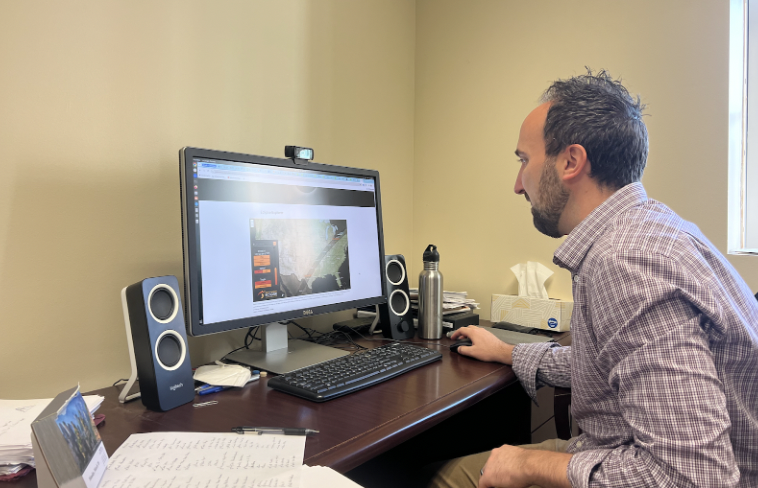The moon rarely positions itself between the Earth and the sun. In this moment, darkness descends and ominous beliefs can arise. Ancient civilizations dreaded this dangerous sign in the sky, interpreting it as the manifestation of an ancient ruler’s death or the anticipation of a scheduled battle. In fear of this foretelling event, ancient peoples carried out purification rituals in their archaic cities in hopes of approval from their respective gods.
The study and analysis of eclipses date back thousands of years. Mesopotamians have been recording and observing eclipses as far back as written records have existed.By circa 500 B.C.E., the Mesopotamians could predict eclipses, said Dr. Melissa Barden Dowling, a history professor at SMU. Moreover, Roman generals used the Mesopotamians’ astrological knowledge to schedule battles on a day of an eclipse to confuse their unknowing enemies in their calculated assaults.
“Others saw it as a bad omen,” Dowling emphasized. “The Romans knew [the eclipse] was coming, so they weren’t scared. It wasn’t a big, earth-shattering event to them.”
“[The Romans] would have to carry out rituals to try and please the gods and bring divine favor back to the community,” Dowling said. “They [believed] that the gods speak to them through natural phenomena.”
What’s the relevance of the total solar eclipse on April 8?
Today, many people will celebrate the impending total solar eclipse because it’s a rare astronomical event. In this spirit, the SMU physics department will host solar eclipse-related festivities on Dallas Hall lawn, said Skye Saltzman, an SMU student majoring in physics. It is predicted to be a cloudy day with a low of 56 degrees Fahrenheit and a high of 80 degrees Fahrenheit. But viewers still should be able to see the effects.
“They are going to hand out glasses,” Saltzman said. “People are flying in for it.”
Purchasing eclipse glasses is essential if you plan on looking directly at the eclipse, added Dr. Joel Meyers, a physics professor at SMU. Looking directly at the sun without glasses can damage your eyes except during totality when the sun is completely blocked by the moon.
“You’ll be able to see at that point, see the [sun’s] corona, and you can do so without eye protection,” he said.
He recommends you share the historical experience with someone you care about.
“Have fun – enjoy the experience together with a big group of people,” he said.
Although we celebrate the eclipse, many cultures feared it and had different interpretations of what is signified.
How various cultures interpret the eclipse:
The Mayans: The Mayans feared the solar eclipse because they believed such occurrences foretold negative events. In Maya culture, ‘Kiinich Ahau is the Sun God and Ixchel is the Goddess of the moon. The Mayans believed that when the solar eclipse occurred, the moon was upset and symbolically, “bites the sun,” according to a Heritage Education Network article. They believed this darkness was a sign that spirits would attack them.
The Incas: The Incas believed that the solar eclipse was a foretelling of the death of a ruler and that the sun was sad. In response, women Incas performed sacrifices to demonstrate their devotion to the sun and appease it, according to a Kibin essay. In their culture, the sun reflected a man and the moon reflected a woman. Thus, the women wanted to please the sun as the men had power over their food.
Ancient China: In ancient China, solar eclipses were seen as a heavenly sign that predicted the destiny of the Emperor and was thought to be caused by a dragon eating the sun, according to a NASA article. Thus, ancient Chinese people would try to scare the dragon away by making loud noises.
Ancient Greeks: Ancient Greeks believed that the solar eclipse was a sign that the gods were unhappy with the people and that the sun was abandoning the earth, according to an Exploratorium article. Thus, the civilization would be left in distress without the sun.
Look here for eclipse misconceptions and myths according to NASA.
The science behind the eclipse:
Ancient world history andscientific theories have shaped individual perceptions about the eclipse today, and thus, they have become a well-known natural phenomenon. Millions of people are planning their day around the event, including the SMU community.
One to four million people are estimated to travel to the areas where totality will occur according to an Eclipse Visitation Model. Travelers excluded, thirty-one million people are in the range of where totality in the United States.
The total eclipse will pass right through the Dallas metropolitan area, which means that many people across the city can see it without traveling far, Meyers said.“Total solar eclipses are quite rare for any particular location on the surface of the Earth,” he said. “This particular one will be quite spectacular because the corona will be very visible during the total period of totality.”
The solar eclipse occurs when the moon passes between the earth and the sun, and the darkness is caused by the moon’s shadow being cast on the Earth’s surface, said Dr. Meyers.
“The next total solar eclipse that will happen in the contiguous 48 United States will be in about 20 years or so,” he said.
The best place to watch the eclipse is somewhere outside in nature with a clear view of the sky where you can see shadows cast by various things, Meyers said.
“The shadows take a really unique form during a partial eclipse,” he said. “You’ll notice that shadows cast by the leaves on a tree, for example, will all be in the form of crescents during the partial phases of the eclipse.”
Whether the total eclipse is viewed as an evil omen or an incredibly eye-opening experience, its rarity is not overlooked.
The next total solar eclipse will occur in August 2044 passing through the United States from Texas to Maine, according to NASA.









